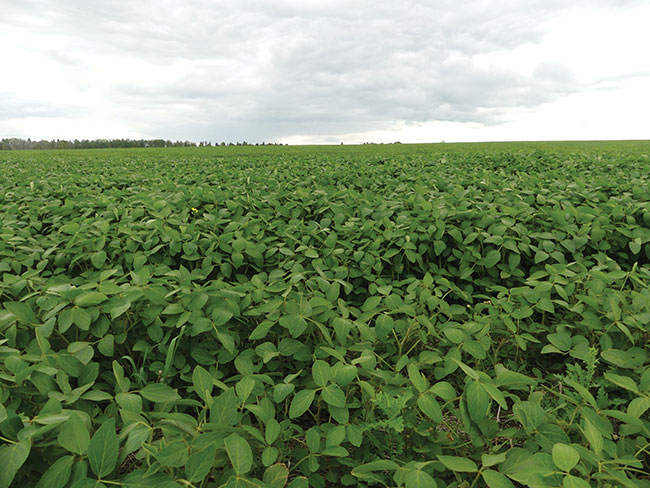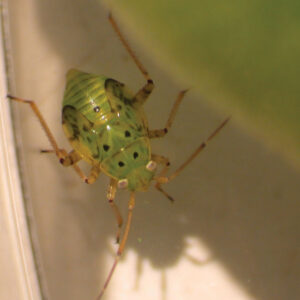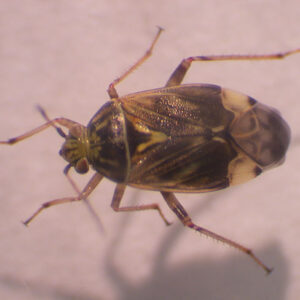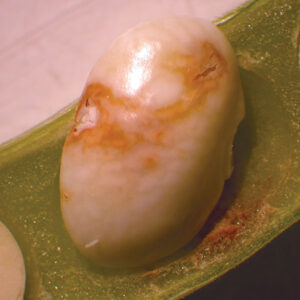
Features
Insect Pests
Lygus bug thresholds remain elusive in beans
But, research identified species composition, life-cycle behaviour and feeding damage characteristics.
March 6, 2023 By Bruce Barker
 Soybean do not seem to be damaged by lygus bug.
Photos by Tharshi Nagalingam.
Soybean do not seem to be damaged by lygus bug.
Photos by Tharshi Nagalingam. In Manitoba, little was known about how lygus bugs, members of the genus Lygus, impact dry bean and soybean, the species composition or the seasonal patterns of lygus bugs on dry beans. A research project was initiated in 2008, completed in 2011, and was recently summarized in two journal papers. While it identified species composition and seasonal occurrence on beans, the research was unable to determine economic thresholds due to low insect pressure during the three years of research. Unfortunately, no research has been conducted since then, although it provides the foundation of understanding on how lygus bugs can cause economic loss.
“The project began with field surveys of dry bean and soybean fields, and resulted in the conclusion that lygus bugs have a single generation on dry beans,” says Neil Holliday, professor emeritus in the Department of Entomology at the University of Manitoba. “Adults come into the fields as the reproductive stages of the plants begin. A generation of immatures goes through on the plants producing adults late in the season.”
The research was conducted by PhD student Tharshi Nagalingam under the supervision of Holliday. Seventeen navy bean, 10 pinto bean and nine commercial soybean fields were surveyed weekly from crop emergence to harvest between 2008 and 2010. Twenty sweep-net samples were taken at five locations in each field. Each sample location was harvested to determine the impact of feeding on yield.
Tarnished plant bugs (Lygus lineolaris) accounted for 78 to 95 per cent of captured adult plant bugs, while alfalfa plant bugs (Adelphcoris lineolatus) accounted for less than 10 per cent, and other species, such as L. elisus and L. borealis, made up the rest of the species captured. Species composition was similar among the different crops.
During the growing season, the development of lygus bug populations was similar in all three years and all crops. Lygus bug adults entered the bean crop in late July around the R1-2 stage of dry bean when the females lay eggs in the stems of the plants. The eggs hatch and nymph populations are the highest at the R4-5 stage persisting into the R6-7 stage. The nymphs then moult to adults, completing a single generation per year. The adult populations also increased at the seed development and filling stages by movement of lygus bugs from adjacent, early-maturing crops.
Tarnished plant bugs were able to reproduce in soybeans, but the nymphs had poorer survival than in dry beans. This, perhaps, partly explains why lygus bugs have not been an issue in soybean in Manitoba.
“In soybeans, some adults come into the crop as plant reproductive stages begin, but few nymphs develop in this crop,” says Holliday.
During the three years of research, yield and quality of beans were not negatively affected by plant bugs due to low pest populations.
Economic thresholds remain to be determined
Holliday says, although the original intent was to produce a threshold for dry beans and soybeans, that objective was not realized for a number of reasons. He says the initial approach had been to use a technique they had successfully applied in studies of lygus on alfalfa. This was to compare yields in plots with natural, and quite high, populations of lygus bugs with plots that were sprayed with an insecticide at full or low doses. “This has the virtue of being as similar as possible to the field situation faced by a producer,” he says.
Unfortunately, lygus bug populations were so low that even in control treatments without insecticide application there was no effect of lygus bugs on dry bean yield quality or quantity. They had hoped to augment populations in the experimental plots with naturally occurring populations nearby, but even there, insufficient populations were available for collection.
Field cage studies were also conducted during the three years, but did not provide reliable results. In one year, high temperatures killed all the lygus bugs in the cages. In another year, the addition of lygus bugs resulted in higher yield.
Feeding damage categorized
Laboratory cage studies were also conducted to determine the impact of feeding by fifth instar nymphs and adults at various growth stages. During flowering to pod initiation, the most common feeding damage resulted in bud, flower and pod abortion.
Early season damage is easy to miss, because the aborted organs fall to the ground; late season injury is more detectable because the damage stays on the plant. During seed development and filling, feeding damage resulted in shrivelled seeds and pods in dry bean, which resulted in reduced seed weight. As seeds were maturing, lygus bug feeding caused direct seed injury, resulting in pitted seed coats. This seed pitting resulted in lower seed quality, but no yield loss in the cage trials. From a farmer’s perspective, dry beans in late-season stages are most at risk from lygus bug feeding since high lygus bug populations moving in from early-harvested crops can cause quality loss in maturing dry beans.
There were no observable differences in the type of injury caused by fifth instar nymphs and the adults at any of the growth stages.
So, while the research was successful in identifying species composition, feeding patterns and feeding damage by lygus bugs, economic threshold work still needs to be conducted.


